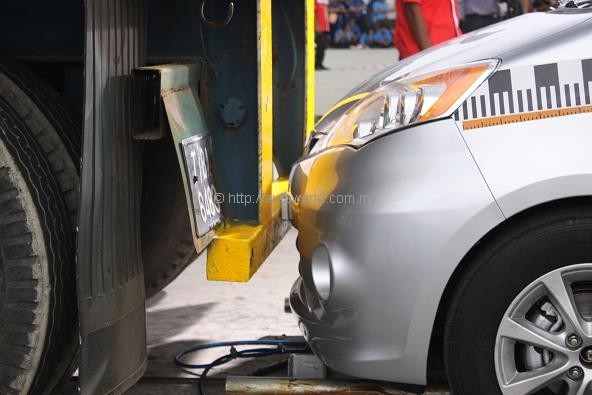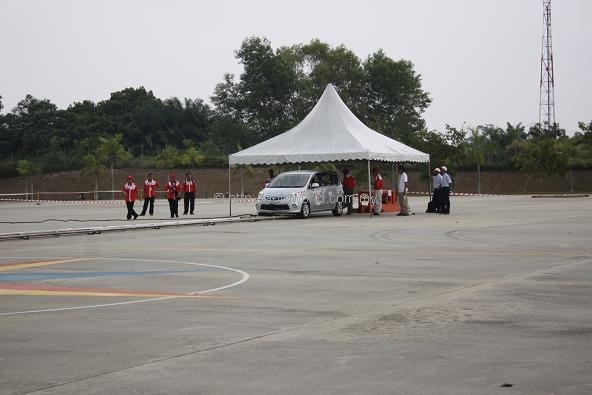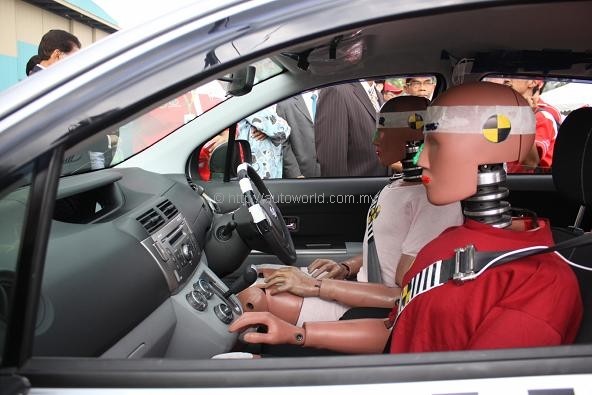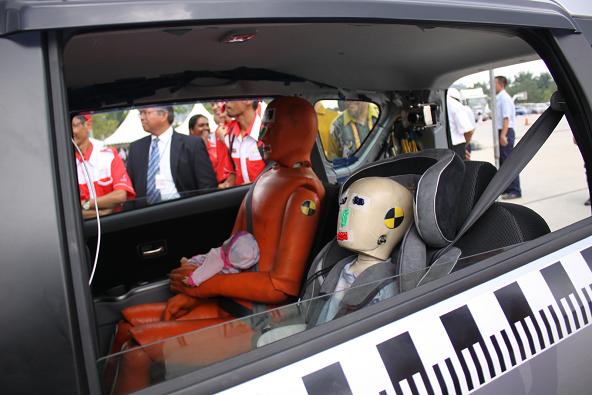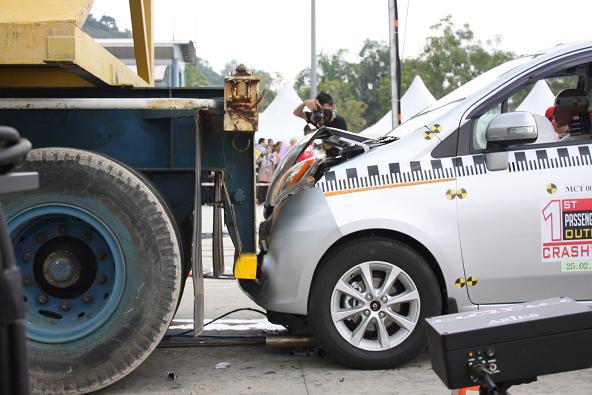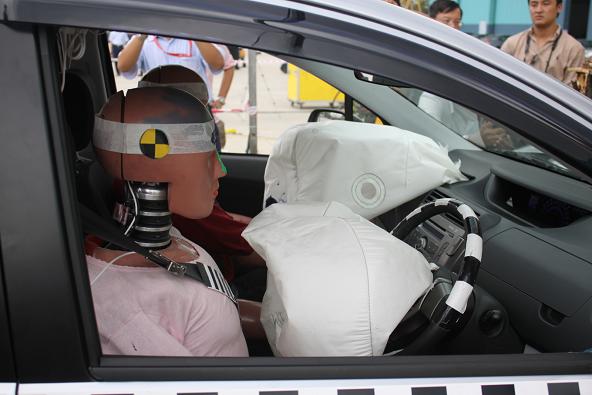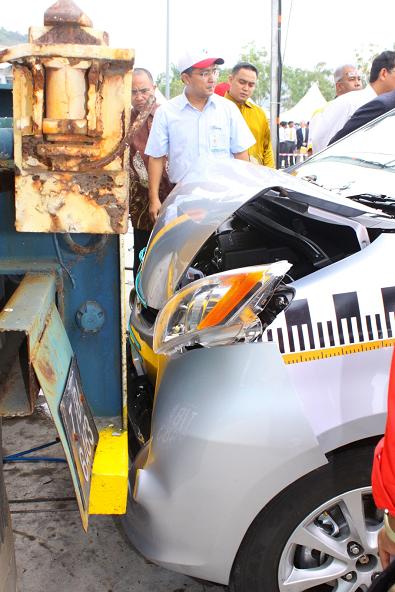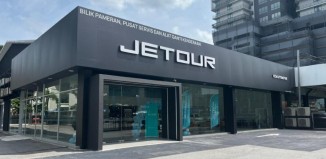MIROS conducts Malaysia’s 1st Passenger Car Outdoor Crash Test
The Malaysian Institute of Road Safety Research (MIROS) yesterday conducted the country’s first ever full-scale passenger car outdoor crash test. Held at the open-air-grounds of the Malaysian Institute of Aviation Technology (MIAT), the test saw a Perodua Alza loaded with four crash test dummies accelerated to hit a stationary trailer at 30kph.
Three critical areas earmarked for analysis from this crash include studying the effectiveness of underrun protection barriers installed at the rear end of long trailers in a collision, comparing the safety levels of children seated at the rear (seat belt vs child seat), and also the degree and types of casualties sustained by occupants when a vehicle collides with a stationary object.
Setup of the experiment saw the Alza accelerated along a railing by means of a pulley-propulsion system powered by a 2.5-litre Nissan engine. The four crash test dummies consisted of two adult and two children-sized dummies. The Alza itself is a standard vehicle pulled out of the factory line. Most of the interior fit and finish were still present, with the exception of the third row seats, which were removed to fit certain hardware elements of the Data Acquisition (DAQ) package.
Waiting for the Alza at the track’s end was a stationary two-tonne trailer carrying a four-tonne load (total: six tonnes). It was installed with an underrun protection with partial compliance to UNECE Regulation 58 which governs design parameters for these systems.
Capturing the action are a total of five high speed cameras capable of a recording speed of 1,000 frames per second. Supplementing these five are a further two from the drive recorder equipment. Various sensors placed throughout the car and dummies further help in the gathering of crash data for post-mortem analysis.
Original design of the experiment was to have the Alza accelerated to a speed of 35kph before hitting the trailer. However, space constraints meant that the car was only able to hit 30kph before colliding. Nevertheless, even at this pedestrian speed, the Alza’s front section experienced substantial damage, though it must be noted that there were no visible damages aft of the A-pillars. The front airbags deployed as designed, ensuring the survival of the front passengers.
Once again, it should be re-iterated that the focus of this exercise was to determine the effectiveness of the underrun protection during a crash rather than to evaluate the Alza’s crash credentials. MIROS officials commented that without the underrun protection, the point of impact between car and trailer might well become the windscreen instead, and we know windscreens are not designed for crash protection.
The underrun protection structure suffered minimal damage from the impact, holding strong apart from a few dents. However, and this is startling, the trailer and its load, with a combined mass of six tonnes, moved visibly forward by about two feet due solely to the forces of impact. This, MIROS officials said, is hoped to help them further illustrate the point how collisions can have fatal consequences even at low speeds.
Speaking at the crash test, which was witnessed by invited guests and media, MIROS Director-General Professor Dr Ahmad Farhan Mohd Sadullah said, “While the law specifies the dimensions and compels commercial vehicles to install these energy absorbing underrun protection systems / barriers according to international standards, there is no form of testing available locally to determine the effectiveness of this system and the level of compliance with regards to the actual materials used in the construction and the strengh of these locally fabricated systems.”
Professor Farhan added, “Meanwhile, in analyzing the degree and type of casualties sustained by occupants of a vehicle involved in a rear-end collision with a stationary vehicle, we believe the findings will be instrumental in enhancing the level of knowledge, skill and competency of medical personnel in handling the trauma of accident victims.”
Nevertheless, one notable point to note is that during the moment of impact, the Alza test car was still being accelerated towards the trailer – a deviation from most crash test practices where vehicles are crashed while traveling at constant velocity. This is a crucial deviation because an accelerating vehicle experiences a much greater force than a stationary one.
When questioned on this matter, MIROS officials commented that this was because there was insufficient space to bring the Alza up to the needed constant velocity and maintain it. To their credit however, they noted that this gave them the opportunity to assess the crash based on a ‘worst case senario’.
Professor Farhan also said the crash test was a prelude to MIROS establishing a full-fledged crash testing facility, which on current schedule, is set to be operational come June 2010.
Based on a three-acre site in Melaka, the new facility will complement the institution’s existing Road Engineering and Environment Research Centre (REER), Road User Behavioural Change Research Centre (RUBC), and Vehicle Safety and Biomechanics Research Centre (VSB). Capabilities to be built into the upcoming facility include simulation of full frontal accidents, side/rear impact testing, rollover, and also testing of road safety furniture, equipment and apparatus.
When fully operational, MIROS hopes that the facility, the first of its kind in South East Asia will become a regional hub for the study, research and analysis of road safety matters.
Pictures: S.R.





